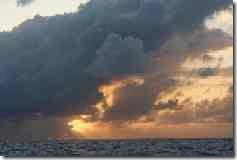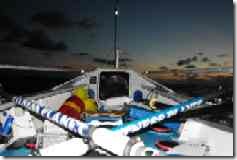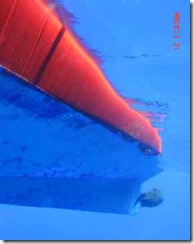12 June, 07 – 15.40
17.0189N,60.5455W
A week ago, I was on deck rowing at around 3.00 am when I was hit by what felt like two waves very close together. A breaking wave followed by a large one right behind it. I will never know exactly what it was. It was quite dark due to the cloud cover. The only light was when the moon and a few stars made a brief appearance between patches of cloud. All I could hear was the hissing of the first wave as the top of it started to break. Then about 2 seconds of silence before the port side was lifted off the water. Just as I thought it would fall back into the water I was hit by another wave, that was impossible to see in the dark.
I was thrown off the rowing seat onto the deck as the force of the wave flipped the boat over. Black water can be very disorienting and my only recollection of what happened next is of surfacing a few feet away. My eyes and sores on the body were burning from the salt. I spotted Miss Olive lying upside down in the water. As the overturned hull rose and fell in the swell I could feel a slight pull on my 10m lifeline (which usually gives plenty of slack) as if it had got entangled with something below the water. Ironically this was more re-assuring than anything else at that time. I swam under to try and free it from what ever it was caught on, but I could not see much in the darkness. Fortunately, I had a spare 6m line trailing from the starboard quarter and grabbed onto that and let go of my original life line.
Out of habit from going over the scenario hundreds of times, the first images to flash thru my mind was the location of the rescue beacons, flares, emergency grab bags, knife, survival suit. I was prepared to spend the rest of the night on top of the hull and wait until daylight to dive below and fetch the survival suit and the rescue beacons.
I was a little worried that the boat did not self-right by itself, as it was designed to do so in a capsize situation. (The self-righting property of the boat, ie: to turn the right way up again – like a kayak). The force of the wave hitting the boat should have been sufficient to push the boat over all the way thru 360 degrees. I was sure the cabin entrance was sealed shut because I triple check this each time I go on deck. It occurred to me that maybe the sea anchor I had left out on deck had deployed and that somehow it was preventing the boat from turning over again. I dived back down under the boat and thankfully found the sea anchor had not yet deployed, but it was starting to roll out of its cover, so I tied it back up.
I decided to have a final shot at manually turning the boat over, using my weight on the lee side together with the momentum of the next wave to turn it over. I remembered there was a beam running the length of the boat, forming a very shallow keel. It was quite difficult to get a grip however, as the surface of the hull was slimy from the barnacles and growth on it. Fortunately I had a t-shirt on and I took it off to clean part of the surface and gripping the mean with the t-shirt was better that with bare hands. I managed to get some more leverage to roll the boat as each wave passed by using the metal railings (normally on the gunwale) at the bottom as a foot hold - so my body was wrapped around the side of the hull.
After a few small waves I was finally lucky enough to get a wave big enough to help me roll the boat over. I count myself very fortunate that I was out on the deck at the time of capsize and not inside the cabin. Had I been inside the cabin, I would have been stuck upside down with questionable chances of rolling it over from inside. I also would have had to open the cabin hatch to get outside resulting in flooding the cabin and making it impossible to right the boat over anyway.
So, why did I capsize?
As I wrote here on the 5th of June, I was forced to take the rudder out as the lashings had come loose and the force of the waves hitting the rudder was vibrating through out the boat. I was unable to get into the water to tighten the lashings because of the open sores on my body. So I took the rudder out and planned to fix it back closer to landfall, when I would need it to steer thru the reefs.
In the meantime, I decided to move some of the water ballast from the center of the boat into the the stern cabin, in the hope that this would weigh it down and keep the stern into the waves as well as make steering without a rudder more manageable.
Unfortunately, the problem with making adjustments to the weight distribution on board is that it's difficult to judge how effective it is unless the boat has been through different sea conditions. When I first adjusted the ballast, the sea was fairly calm and the change seemed to be helping, so I kept it. However, at the time of capsize the weather changed and I found the boat responded in a different manner. Though the conditions were not unusual (I've been thru heavier seas in this boat). My conclusion is that the boat was lighter after consuming all the food on board and moving some more weight from the middle to the stern increased the instability and caused the capsize.
Why did it not self-right?
When I self-righted the boat, I discovered that one of the watertight compartments on deck, holding the watermaker and the batteries was open (I must have left it open whilst trying to fix the watermaker). I'm not sure if this caused any extra resistance to the movement of the hull turning back over. I'm also not sure how the extra weight at the stern affected the self-righting.
Whats the damage?
The force of the boat turning over, cracked one of the carbon fiber oars, that got trapped underneath the boat. I also lost the power supply. It's hard to say where or how water entered the system or if it was the water on the battery that created a short circuit in the system.
The casualty list of things lost over board includes: video camera, ipod, sunglasses, sports water bottle, skin cream for sores, deck barometer and compass, star charts.
Anyway, that's a few less things to drag thru the water!
In the words of Bond, still little shaken, but not stirred.
48 miles left for a warm meal...
B
Email: mail@bhavik.com
Confused by any of the nautical terms? Visit the Glossary: http://www.bhavik.com/crossatlantic/about_glossary.htm
Get automatic alerts each time news is updated: http://www.humanedgetech.com/expedition/bhavik/newsletter/index.php
Send me a short message via my webpage http://www.bhavik.com/crossatlantic/messages.asp
Squall passing overhead, heading West, Taken @ 23.20 PM 06 Jun
Deck
View of the hull underwater. Beam that runs the length of the boat that I used to turn the boat over




No comments:
Post a Comment